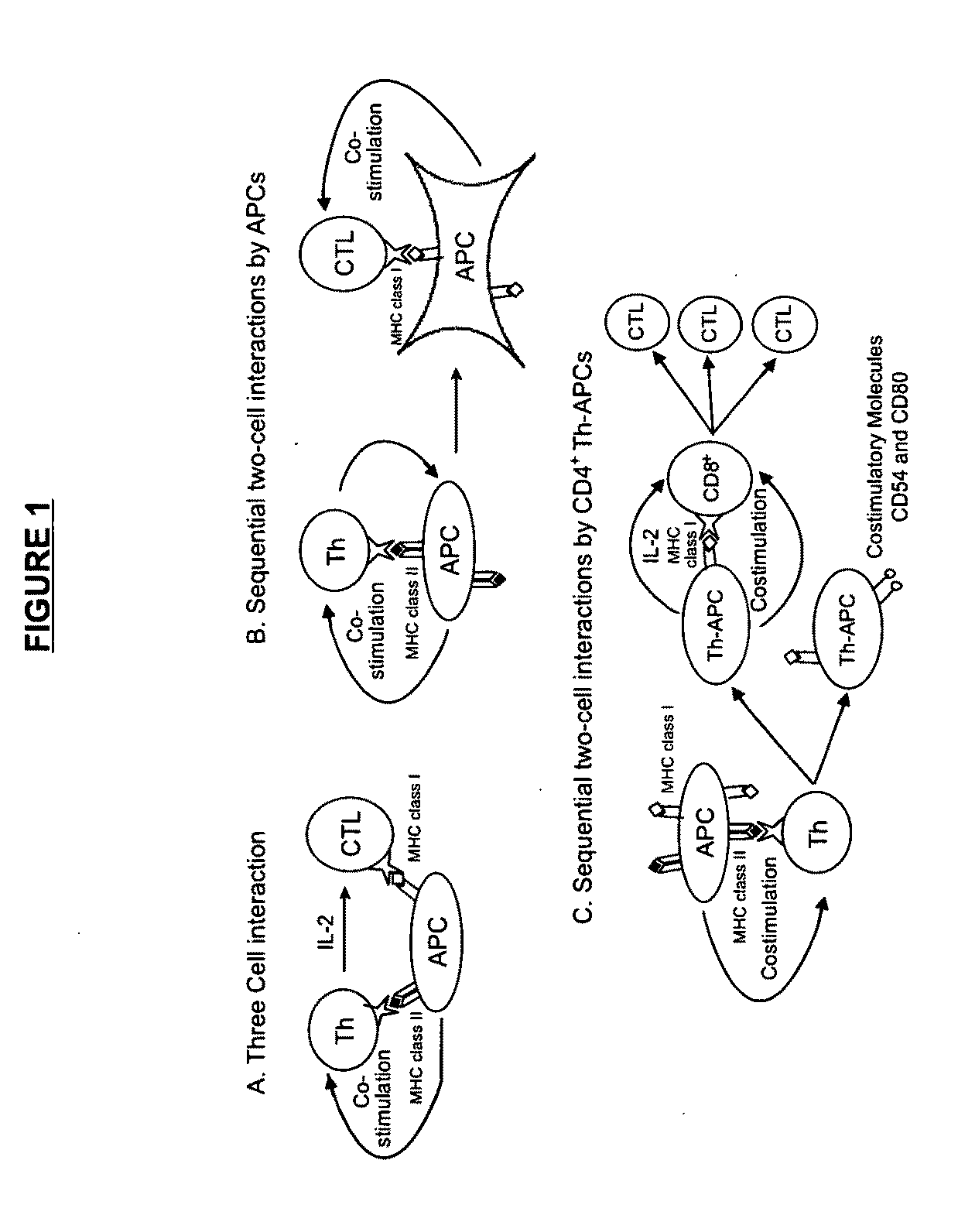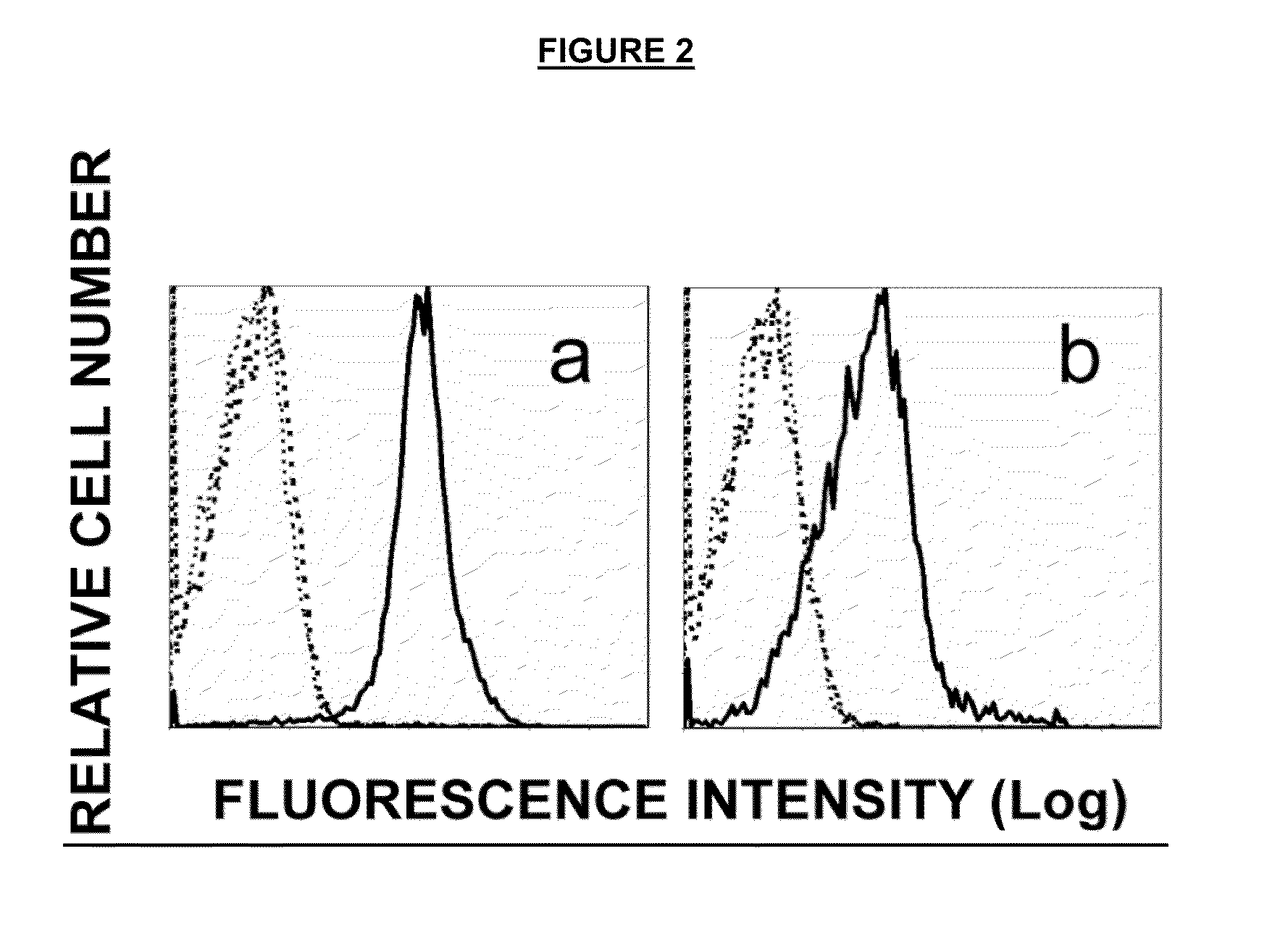Materials and Method of Modulating the Immune Response
a technology of immune response and material, applied in the field of modulating the immune response, can solve the problems of not explaining how, not accurately modeling the physiology of th cell-dependent immune responses in vivo, and not compellingly explaining the temporal gap
- Summary
- Abstract
- Description
- Claims
- Application Information
AI Technical Summary
Benefits of technology
Problems solved by technology
Method used
Image
Examples
example 1
CD4+ T Helper-Antigen Presenting Cells
Materials and Methods
Tumor Cells, Reagents and Animals
[0101]The highly lung metastatic B16 mouse melanoma BL6-10 and OVA-transfected BL6-10 (BL6-10OVA) cell lines were generated by the inventor (30). Both cell lines form numerous lung metastasis after i.v. tumor cell (0.5×106 cells / mouse) injection. The mouse B cell hybridoma cell line LB27 expressing both H-2Kb and Iab, the mouse thymoma cell line EL4 of C57BL / 6 mice and the OVA-transfected EL4 (EG7) cell line which is sensitive to CTL killing were obtained from American Type Culture Collection (ATCC, Rockville, Md.). Both BL6-10 and BL6-10OVA express similar levels of H-2Kb, but not Iab. Both BL6-10OVA and EG7 cells expressed OVA by flow cytometric analysis, whereas BL6-10 and EL4 cells did not (FIG. 2). T cell hybridoma cell line RF3370 expresses TCR specific for H-2Kb / OVA peptide complexes (31). The biotin-labeled monoclonal Abs specific for H-2Kb (AF6-88.5), Iab (AF6-120.1), CD3 (145-2C11),...
example 2
Targeting CD4+ T Cells with Exosomes
Materials and Methods
Reagents, Cell Lines and Animals
[0126]Ovalbumin (OVA) was obtained from Sigma (St. Louis, Mo.). OVA I (SIINFEKL) (SEQ ID NO:1) and OVA II (ISQAVHAAHAEINEAGR) (SEQ ID NO:2), which are OVA peptides specific for H-2Kb and Iab, respectively (33,32). Mut I (FEQNTAQP) (SEQ ID NO:3) peptide is specific for H-2Kb of an irrelevant 3LL lung carcinoma. All peptides were synthesized by Multiple Peptide Systems (San Diego, Calif.). Biotin-labeled or fluorenscein isothiocyanate (FITC)-labeled antibodies (Abs) specific for H-2Kb (AF6-88.5), Iab (AF6-120.1), CD3 (145-2C11), CD4 (GK1.5), CD8 (53-6.7), CD11c (HL3), CD25 (7D4), CD40 (IC10), CD44 (IM7), CD54 (3E2), CD62L (MEL-14), CD69 (H1.2F3), CD80 (16-10A1), IL-7R (4G3) and Vα2Vβ5+ TCR (MR9-4) as well as FITC-conjugated avidin were all obtained from Pharmingen Inc. (Mississauga, Ontario, Canada). The anti-H-2Kb / OVA I complex (pMHC I) Ab was obtained from Dr. Germain (National Institute of Heal...
example 3
Targeting Dendritic Cells with Exosomes
Materials and Methods
Reagents, Cell Lines and Animals
[0150]Ovalbumin (OVA) protein was obtained from Sigma (St. Louis, Mo.). OVA I (SIINFEKL) (SEQ ID NO:1) peptide (33,32) and Mut I (FEQNTAQP) (SEQ ID NO:3) peptide specific for an irrelevant 3LL lung carcinoma (34) were synthesized by Multiple Peptide Systems (San Diego, Calif.). Biotin-labeled and fluorescein isothiocyanate (FITC)-labeled antibodies (Abs) specific for H-2Kb (AF6-88.5), Iab (AF6-120.1), CD4 (GK1.5), CD8 (53-6.7), CD11c (HL3), CD40 (IC10), CD54 (3E2), CD80 (16-10A1), CD44 (IM7), MyD88, CCR7 (4B12) and DC-specific ICAM-grabbing non-integrin (DC-SIGN) (5H-11) were obtained from Pharmingen Inc (Mississauga, Ontario, Canada). The anti-H-2Kb / OVA I (pMHC I) complex Ab was obtained from Dr. Germain (National Institute of Health, Bethesda, Md.) (62). PE-labeled H-2Kb / OVA I tetramer Ab was obtained from Beckman Coulter (Mississauga, Ontario, Canada). Biotin-labeled Toll-like receptor (TL...
PUM
| Property | Measurement | Unit |
|---|---|---|
| diameter | aaaaa | aaaaa |
| volumes | aaaaa | aaaaa |
| temperature | aaaaa | aaaaa |
Abstract
Description
Claims
Application Information
 Login to View More
Login to View More - R&D
- Intellectual Property
- Life Sciences
- Materials
- Tech Scout
- Unparalleled Data Quality
- Higher Quality Content
- 60% Fewer Hallucinations
Browse by: Latest US Patents, China's latest patents, Technical Efficacy Thesaurus, Application Domain, Technology Topic, Popular Technical Reports.
© 2025 PatSnap. All rights reserved.Legal|Privacy policy|Modern Slavery Act Transparency Statement|Sitemap|About US| Contact US: help@patsnap.com



